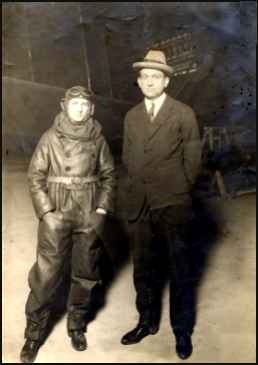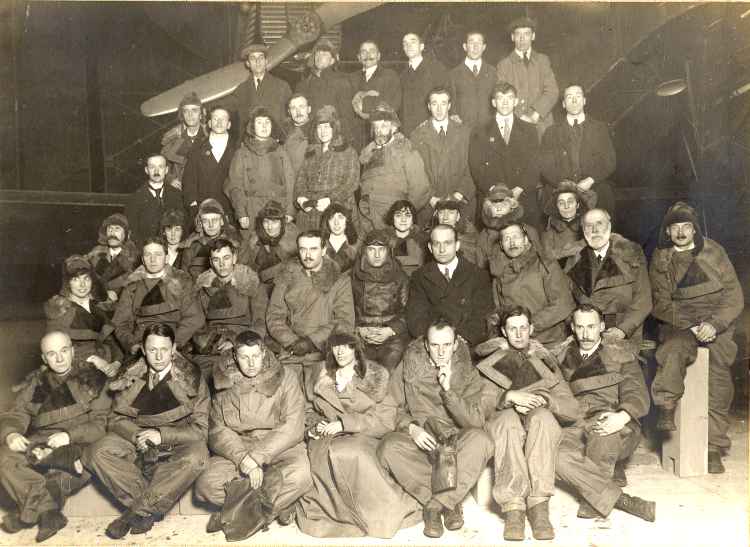
1889-1920 AKA CB Prodger |
 |
Collection of Kim Prodger, 4-26-05 |
 |
Collection of Kim Prodger, 4-26-05 |
via email from Kim Prodger, 4-25-05 Thank you so much for putting C.B.P. on the web. My father, his son, died in late November. Seeing the article you transcribed has meant so much to the entire family. Thanks, Kim Prodger |
via email from Peter Jensen, 5-27-05 Bruce's article is of course more than I can transcribe but the web has fine information on it: Editor's Note: An especially helpful website which offers several photographs and drawings of the plane may be accessed at: Ellen Elder suggests that the language of this website is Polish. If you can help us with a translation of a portion of the text, I would love to hear from you. |
 |
TAKEN AFTER A FLIGHT AT 6500 FEET IN A HANDLEY PAGE AEROPLANE |
| CRICKLEWOOD AERODROME | 15th NOVEMBER 1918 |
Collection of Kim Prodger, 4-26-05 |
via email from Ellen Elder, 1-10-05 Regards, Ellen |
North Down Spectator article Saturday December 28, 1918 issue, page 3. Transcribed by Ellen Elder, 2-16-05 THE LATEST TYPE OF AEROPLANE TEST FLIGHT OVER BELFAST The machine represents the latest development in aircraft design and construction and suggests the tremendous possibility of the aeroplane for the purposes of transport. It is not too much to say that the flying machine has been one of the leading factors in the determination of the War. In the early stages of the campaign Germany had the advantage in this branch of equipment but Britain and her allies subsequently obtained a decided superiority and the deeds of our gallant airmen will be recorded in letters of gold in the pages of history as achievements without parallel for daring and devotion. With the termination of the war inventors will turn their attention to the adaption of the aeroplane to the needs of commerce and industry and already its utility in this respect has been convincingly demonstrated. 6 or 7 years ago an aeroplane flight was regarded as a great adventure only to be undertaken by the bolder spirits amongst us but it is now recognized that, provided the machine is in charge of an experienced pilot, there is as little danger in travelling through the air at 80-100 mph as in journeying on an express train moving at 40-50 mph. One can easily conceive of the time when the aeroplane will be a powerful rival to the railway train and the motor car in the conveyance of passengers. Air mail services have already been established in various parts of the world and there is no reason why we should not also have equally efficient passenger services by aeroplane. The chief obstacle in the way of this departure up to the present has been the limited capacity of the machines but that difficulty is gradually being overcome and only the other day an aeroplane flew over London with 40 passengers. It is interesting to note that Mr Prodger, the pilot of the new Aldergrove aeroplane, also steered the machine built for the London experiment and he is very optimistic as to the ability of inventors to design large craft giving as much security from the standpoint of safety as the modern railway train and also capable of being worked economically when put to commercial activities. There are still many people who would hesitate to make a voyage in an aeroplane but that is simply because owing to its novelty they have exaggerated the risks involved. Exactly the same feeling prevailed in reference to railway trains when the first railroads were constructed and in some isolated districts even the motorcar, the acme of safety and comfort, was looked upon with fear and suspicion until a few years ago. The aeroplane has assuredly come to stay and 20 years hence people will probably travel by air in preference to going by rail or sea in cases where long distances have to be traversed. Those who saw the new machine in its flight must have been impressed by its grace and stability and perhaps they would be inclined to envy the occupants the glorious sense which they enjoyed in soaring high among the clouds with the towering landmarks below reduced to mere specks by the perspective in which they were placed, It may be added that hundreds of aeroplanes have been built at the Aldergrove Aerodrome during the past 18 months and in adapting their great resources to the requirements of this industry, Messrs Harland & Wolff have proved that the initiative and enterprise which won worldwide renown for their Queen's Island Works can ensure an equal measure of success when directed into new channels of activity. Comments from Ellen Elder: "The language of 1918 newspapers is very quaint but I think conveys the spirit of the times and the excitement felt at this very new form of transport. Harland & Wolff as I expect you know built the Titanic and were the number one employers in Belfast for many years. Short Bros and Harland went on to become the main aircraft industry in the city while Harland & Wolff continued with shipbuilding. Unfortunately now they are greatly reduced in output but have a new line in servicing oilrigs. Shorts, where my father worked as a tool fitter for many years, is now run by Bombardier, a Canadian outfit." |
|
Early Wright Exhibition Pilot - Instructor by M. E. Morehouse Extract from biography Collection of Rolland DeRemer - 12-8-03 Having made the acquaintance of George Beatty, and favoring the Wright plane, DeRemer decided on the Beatty School the following spring and arrived at the Nassau Boulevard, L.I. flying field for instruction on February 9th, 1912. Also training there at that time were Charles Horton, Dr. A. G. Belden, Clarke Thompson, William Reid, Marshall Reid, Clifford Prodger, Wilbur Andrews, William Piceller and F. W. Kemper. DeRemer was an apt pupil and made his first solo flight on April 13th after only two and one-half hours of instruction time. Fellow student and wealthy sportsman, Marshall Reid furnished DeRemer's bond for possible accidental damage for his solo flight. On Friday, April 19th, 1912 DeRemer obtained Pilot License No. 115, flying a Beatty Wright, and broke the local record for his flight tests by completing them in 19 minutes and flying to 700 feet. This was 5 minutes less than the nearest previous time. Beatty regarded this as phenominal and asked DeRemer to remain with him as assistant insturctor, which was declined because he wished to return to Bay City and start his aviation career in his home town. |
|
|
|
Once on the page, you may want to use the FIND function on Prodger to located the entry on the page. |
|
|
|
|
|
Greater Belfast About Your Place & Mine. A firm favourite on BBC Radio Ulster for over 13 years, Your Place & Mine has an ever increasing number of listeners. The programme & website reflect the mosaic of life in Northern Ireland. In 2004, Ellen Elder submitted the following story. "Ellen Elder - April 04: Apropos Shorts making motor cars, I was interested to read recently that Harland & Wolff built aeroplanes at the Aldergrove aerodrome during the lst world war. One which was test-flown by the American test pilot C.B. Prodger was at the time one of the largest ever built. It could carry enough fuel to keep it going for 15 hours at a stretch and had a speed of 100 mph. The span of the wings was 126 feet and the plane was originally intended to take part in the bombing of Berlin but as it was now December 1918, it was a little late. It was decided to utilise the plane in connection with the Indian mail service. The article goes on to say that "One can easily conceive of the time when the aeroplane will be a powerful rival to the railway train and the motor car in the conveyance of passengers.....during the past 18months and in adapting their great resources to the requirements of this industry, Messrs Harland & Wolff have proved that the initiative and enterprise which ha! have won worldwide renown for their Queen's Island works can ensure an equal measure of success when directed into new channels of activity." |
|
Editor's Note: If you have any more information on this Early Bird, please contact me. E-mail to Ralph Cooper Back 

|